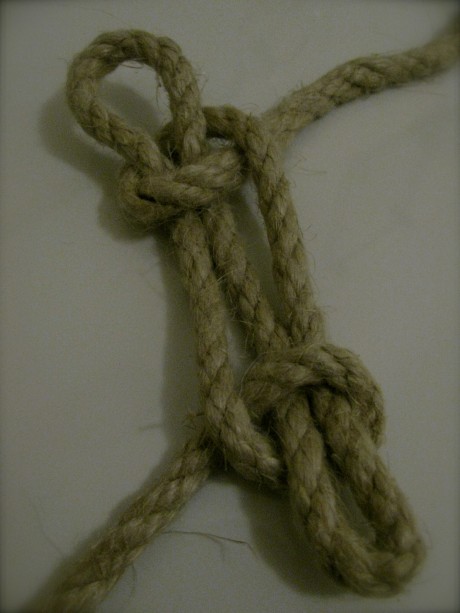We’re giving you a sneak preview of Dr Mark Knutsson’s feature ‘101 knots we can’t live without’, where he tells us about his fav knots and how they got their names. To read the full feature, pick up a copy of Let’s Knot – in stores soon!
Manrope Knot
The Manrope Knot, or Wall and Crown Knot, forms a button at the end of a rope and has typically been used as the basis for the heads of characters in classic “Rope and Judy” plays (a variant on Punch and Judy in which each puppet consists of a piece of rope).
The knot is so called because, until the mid-1920s, when it had already been providing puppets’ heads for over a century, it was almost universally believed impossible for a woman to tie. It was then people realised that up to that point no woman had really been trying very hard and that it actually was really not that difficult. Sadly, Rope and Judy theatre went out of fashion shortly after and, consequently, rope puppet-making remained to the end a male-dominated trade.
Below: Manrope knot

Bottle Sling
This knot’s alternative name, the Double Jug Sling, has frequently led to mistaken assumptions about its origin and purpose. In fact, it has nothing at all to do with ladies’ undergarments. The name Bottle Sling makes its true origin much plainer – it was, of course, devised for the easy and accurate projection of drinking vessels in street fights. Indeed, what started as a prudent accessory in friendly brawls in the Boston suburbs in the 1890s ended up, by the late 1930s, one of the most vicious weapons in use by street gangs in Glasgow – the notorious so-called “sling gangs”.
The knot is tied around the neck of the bottle and, since the clamp-down on sling gangs, has been largely used to hang bottles, for example on a bottle rail or in a jug-drobe, or water closet. Even today, it is consistently voted the most popular method of large-scale, vertical bottle storage in the annual bottle storage survey carried out by the Bottle and Phial Society (BAPS).
Below: A typical jug-drobe seen in any modern middle-class house.

Sheepshank
Aside from its obvious everyday practical uses shortening livestock tethers, what adds a particular charm to this knot for me is the lovely, and cautionary, tale behind its name.
The Lord Arthur Penelope Hancock Shaftesbury was well known for his prowess and exceeding self-esteem at the card table. Notorious among the aristocracy of 1780s Dorset, he was especially known for his ostentatious and idiosyncratic victory dances. By 1788, he was known almost exclusively by the ironic nickname Timid Hancock Shaftesbury.
On the night of the 28th April, he secured a spectacular victory in a hand of Riddlesome Fives over the Duke of Portland, William Cavendish-Bentinck. Being several ports the merrier than Portland, he embarked on what onlookers described as “quite the most vulgar and demoniac contortion of a gigue imaginable”. Such was the headstrong vivacity of his gambol that, spinning blindly across the room, he crashed through a valuable stained-glass window and plunged, still writhing, into the ornamental flower bed below. It so happened that several of the sheep that roamed the estate were in the near vicinity and, roused from contemplation by the commotion, darted in the direction of the open countryside, trampling the incapacitated peer as they went.
The assembled crowd, watching from the window above, erupted with laughter and immediately coined a new nickname – Sheepish Hank Shaftesbury. The story soon became well known in the area and local farmers, who had already named a knot the Timid Hancock, after its resemblance to the earl’s notorious victory dance, promptly adopted a new name – the Sheep’sh Hank.
Below: Sheepshank

Turk’s Head
The Turk’s Head is a widely used decorative knot that can be tied in a cylindrical shape or flat, to produce a mat, and was named by someone who had never been to Turkey, but had spoken to someone who said he had.
During the October Revolution, the knot became popular with leading Bolsheviks after Lenin mentioned late one night at a party that his host’s Turk’s Head doormat looked like lots of little sickles dancing around one another. Soon, every state building had a Turk’s Head mat hanging from its door and party leaders wore a cylindrical Turk’s Head around each ear in all official photographs. Shortly afterwards, the Politburo had all photos airbrushed to remove what, it was then realised, was a stupid idea from the start. Today, outside Russia, the knot has no communist connotations.
Below: Detail from an archive photograph, smuggled from Russia in 1918.

Endless Knot
Many cultures associate symbolic meaning with this knot, but one stands out in particular. An ancient myth told by the people of northern Tibet tells of a warrior, Lhundup Nor’Phrul. Lhundup suffered a terrible injury in a battle and knew that he had only days to live. In desperation, he mounted his horse and set out from his village through the mountains. Reaching a high mountain pass, weakened by his wound and the altitude, he fell from his horse, unconscious. In a dream, he was visited by a mysterious creature, rather like a badger (though he was, naturally, unaware of the resemblance). The apparition handed him a piece of cord and instructed him to tie it round himself securely – a sort of seatbelt for his trip to the afterlife (though, again, the allusion was lost on Lhundup). Being a crafty fellow, the warrior began to play for time, tying the rope round and round, never reaching an end. (Being a mystical rope, it was not entirely committed to any particular dimensions, meaning that such practical details were no barrier to our wily hero’s tactics.)
Seeing what was going on, the ethereal mustelid brokered a deal with gallant Lhundup – that he might go on living for as long as he could keep on with his little knot-tying game. Unsure of whether this was a genuine offer or just a patronising put-down, Lhundup accepted.
Now, what makes this story unusual among myths is that it is true. Fiddlesticks!, you cry (no doubt). But, as it happens, I have met the chap and he’s still tying his knot to this day. He works, these days, for the London Underground and, if you can catch him on one of his breaks, he’ll be happy to recount this tale and others to you, provided you take care not to distract him from his eternal knotting task.
Below: An unfinished endless knot.

Keep an eye on our Facebook and Twitter pages for some great ideas and tips for budding knotters!



_333_180_c1.png)


_Craftihive_Let_s_Knit_Website_Blog_-_7.9.25_HEADER_IMAGE-01__333_180_64_c1.jpg)

_333_180_64_c1.jpg)
 Baby
Baby
 Toys
Toys
 Garments
Garments
 Crochet
Crochet
 Homewares
Homewares
 Dolls
Dolls



Share